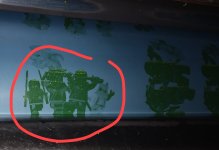Hi,
When running heavy black solids I get pilling on the tail edge of the solid. I've tried two inks, but no change. Different blankets, but no change. Can anyone give me some ideas to try or to look for? The problem doesn't seem to ever happen to the K control bar.
Attaching dropbox images as site only lets me upload smaller photos:
https://www.dropbox.com/s/uy8ymouhavk6u6c/Image.jpeg?dl=0
https://www.dropbox.com/s/ebxn33xzvot67jo/Image-1.jpeg?dl=0
When running heavy black solids I get pilling on the tail edge of the solid. I've tried two inks, but no change. Different blankets, but no change. Can anyone give me some ideas to try or to look for? The problem doesn't seem to ever happen to the K control bar.
Attaching dropbox images as site only lets me upload smaller photos:
https://www.dropbox.com/s/uy8ymouhavk6u6c/Image.jpeg?dl=0
https://www.dropbox.com/s/ebxn33xzvot67jo/Image-1.jpeg?dl=0












